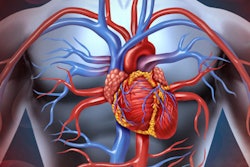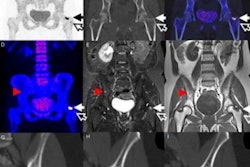
A head-to-head comparison to determine the most accurate modality for diagnosing myocardial ischemia has found that PET outperforms SPECT, coronary CT angiography (CCTA), and hybrid variations of the three modalities in patients with suspected coronary artery disease (CAD), according to a study published online August 16 in JAMA Cardiology.
While PET demonstrated better accuracy than CCTA and SPECT for the condition, another noteworthy finding is that combining CCTA with SPECT or PET did not improve the detection of CAD among these symptomatic patients.
"We observed no incremental diagnostic value of hybrid imaging compared with standalone testing," wrote the group led by Dr. Ibrahim Danad from VU University Medical Center in Amsterdam. "Although the addition of functional imaging to CCTA improved specificity, the increase in false-negative findings affects clinical decision-making in an unfavorable manner."
Lack of guidance
Currently, there are no U.S. or European guidelines, nor have there been comparative studies, that recommend or affirm one imaging modality over another for the diagnosis of ischemic heart disease, the authors noted.
"At present, the choice of noninvasive testing for a diagnosis of significant coronary artery disease is ambiguous, but nuclear myocardial perfusion imaging with SPECT or PET and coronary CT angiography is predominantly used for this purpose," they wrote (JAMA Cardiol, August 16, 2017).
For the prospective, single-center study, the researchers enrolled 208 consecutive patients between January 2012 and October 2014 at the VU University Medical Center. The 132 men and 76 women (mean age, 58 ± 9 years) presented with stable chest pain and suspected CAD and subsequently underwent CCTA, PET, and SPECT.
The CCTA protocol assessed the right coronary artery, left main artery, left anterior descending artery, and circumflex artery; the primary threshold was defined as a visually estimated diameter of stenosis of at least 50%. Technetium-99m tetrofosmin-labeled SPECT myocardial perfusion imaging (MPI) was used to investigate 17 segments to determine the degree of perfusion abnormality.
In addition, oxygen-15-water PET was used to assess myocardial segments, and those with blood flow of 2.30 mL/min/g or less were considered abnormal. The researchers also sought to assess the efficacy of the modalities in hybrid form by fusing CCTA images separately with SPECT results and then with PET results.
Within two weeks, the patients also underwent invasive coronary angiography and fractional flow reserve (FFR) measurements for all coronary arteries. All patients continued to receive their medications during the study period.
Among the 208 patients, 92 (44%) had significant CAD, with most of the lesions located in the left anterior descending artery (81 patients, 39%), followed by the right coronary artery (39 patients, 19%) and the circumflex artery (38 patients, 18%). In addition, 160 (26%) of the 615 vessels evaluated contained significant stenosis.
Modality reviews
Image quality was judged as good or excellent in 194 (94%) of the 206 SPECT studies, 183 (88%) of the 208 CCTA studies, and 175 (86%) of the 204 PET scans.
From a diagnostic perspective, PET was the most impressive modality, with diagnostic accuracy of 85% for coronary ischemia, followed by SPECT and CCTA. PET and CCTA were comparable in terms of sensitivity, while SPECT was most proficient for specificity.
| Modalities' efficacy in diagnosing ischemic heart disease | |||||
| CCTA | SPECT | PET | SPECT/CCTA | PET/CCTA | |
| Sensitivity | 90% | 57% | 87% | 50% | 74% |
| Specificity | 60% | 94% | 84% | 97% | 92% |
| Positive predictive value | 64% | 88% | 81% | 94% | 88% |
| Negative predictive value | 89% | 73% | 89% | 71% | 82% |
| Accuracy | 74% | 77% | 85% | 76% | 84% |
Interestingly, diagnostic accuracy did not improve with hybrid SPECT and CCTA (76%, p = 0.75) or by matching PET with CCTA (84%, p = 0.82). Hybrid SPECT with CCTA achieved greater specificity (97%, p = 0.004) than either CCTA or SPECT alone, but it offered significantly less sensitivity (50%, p = 0.001) than either individual modality.
Combining PET with CCTA provided specificity of 92% (p = 0.004), compared with PET alone (84%), but it resulted in a lower sensitivity of 74% (p = 0.001), compared with PET alone (87%).
As for mean effective radiation dose, the dose delivered by SPECT (6.01 ± 0.70 mSv) was significantly greater than with CCTA (5.31 ± 1.32 mSv, p < 0.001) and PET (3.10 mSv, p < 0.001). Hybrid SPECT/CCTA yielded a mean effective radiation dose of 11.3 (± 1.48) mSv, while PET with CCTA had a mean effective radiation dose of 8.41 (± 1.32) mSv (both p < 0.001).
"The widespread use of CCTA coupled with SPECT or PET will result in increased radiation exposure to the patient and may mitigate its utility in a clinical setting," the authors wrote.
Clinical relevance
The prevalence of disease among the study's subjects was greater than in other studies investigating the diagnostic accuracy of imaging modalities to detect CAD; however, Danad and colleagues suggested the results could extend to other heart patients.
"The present findings can be extrapolated to patients at low risk of CAD in whom specificity of a test is less important," they wrote. "It is expected that with increasing prevalence, the negative predictive value of imaging will increase at the cost of specificity and positive predictive value."
In an accompanying editorial published on the same date, Dr. Pamela Douglas, a professor at Duke University School of Medicine, congratulated the authors "on completing this very ambitious and challenging clinical study."
And while the study "represents an important step in the evolution towards enhancing the value of imaging" and adds "substantially to our imaging knowledge base," she also cautioned that there remains much more to learn.
"How do these findings translate into effectiveness and not just efficacy? How would changes in testing practices affect patient care processes or outcomes?" she wrote. "And increasingly in the current concerns about healthcare spending, is the cost commensurate with the information derived?"



















